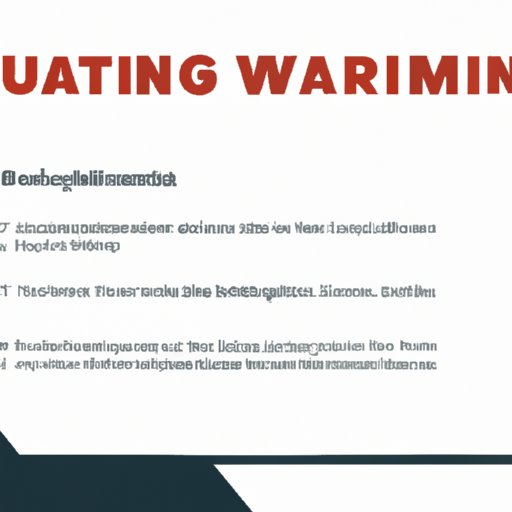
I. Introduction
When it comes to finding a job that fits your background and qualifications, your resume is a crucial part of the process. Your education is one of the key factors many employers will consider when reviewing job applications. Highlighting your academic achievements and qualifications can set you apart from other candidates and help you secure a job interview.
However, many candidates struggle with effectively showcasing their education on their resume. They are often unsure of how to highlight their academic credentials and which details to include. In this article, we will explore the best practices for writing education on a resume and provide tips to help candidates craft an impressive resume.
II. “5 Effective Tips for Highlighting Your Education on Your Resume”
One of the best ways to make your resume stand out is by highlighting your education. Here are five effective tips to help you showcase your academic background on your resume:
A. Tips for highlighting education in a clear and concise manner
Ensure that your education section is clearly labeled and located at the beginning or middle of your resume, depending on your level of experience. Use a straightforward format to list your education in reverse chronological order, starting with the most recent education. Include the name of the degree, your major, the name and location of the school, the date of graduation (or expected graduation), and any relevant academic achievements, such as cum laude or Phi Beta Kappa. Keep this section concise and avoid adding unnecessary details.
B. How to make education stand out among other qualifications
In addition to your education section, you can also highlight your academic achievements throughout your resume. For example, if you received an academic award or scholarship, mention it in your experience section. If you completed a significant research project or internship related to your field, mention this under the relevant section also. Emphasize any extracurricular activities or academic clubs that align with your career goals.
C. Examples of successful resumes with impressive educational backgrounds
Explore sample resumes online to get ideas for how others have showcased their education on their resumes. This will give you ideas on how to format your own resume and what to include in your education section. Use these examples to inspire and guide you as you develop your own resume.

III. “Crafting a Winning Resume: Maximizing the Impact of Your Education”
Your resume should not only demonstrate your academic credentials but also how well they align with the requirements of the job you are applying for. Here are three tips to help you tailor your education to specific job descriptions:
A. How to tailor education specifically to the job description
Before submitting your resume, research the company and job description to understand their requirements. Then, highlight specific courses or academic achievements that align with the job description. For example, if you are applying for a marketing position, emphasize any marketing courses you have taken, or if you have a degree in economics, highlight how this connects to the company’s business objectives.
B. How to use education to appeal to specific hiring managers or recruiters
When applying for certain jobs, it may be beneficial to emphasize specific education credentials that appeal to your target audience. For example, if you are applying for a teaching position, highlight your education credentials related to education and certification. Highlight the relevancy of your coursework to show how you have developed the skills and knowledge to excel in a particular role.
C. How to use education as a selling point for specific industries
In some industries, specific academic credentials are required for certain positions. For example, a law degree is often required for certain legal professions. When applying for these positions, emphasize your education qualifications in a way that appeals to those hiring managers. Emphasize how your academic background aligns with that industry.
IV. “Mastering the Art of Writing Education on Your Resume: A Comprehensive Guide”
Here is a guide on how to craft your education section on your resume:
A. A detailed guide to crafting an education section on a resume
List your education in reverse chronological order, with your most recent degree first. Include the degree or diploma type, major or areas of study, institution name, and the expected or completed graduation date. Also, list any academic awards, distinctions, or honors you have received that are relevant to the job you are applying for.
B. Tips for formatting and organizing education details
Maintain a clean and organized format for your education section. Use bullet points to make lists, use a legible font and use a consistent formatting style. Also, avoid formatting inconsistencies with bold, underline or any other approach when highlighting details so that it does not distract from the content of your resume.
C. Maximizing space on a resume while still showcasing education
Provide a brief overview of your education and ensure it is no more than one or two lines. Alternatively, you can minimize the space needed by mentioning your education under relevant work experiences or professional development. This approach keeps your education credentials in focus while still keeping your resume compact.
V. “From GPA to Relevant Coursework: How to Showcase Your Education on Your Resume”
Make the most of every aspect of your education and how it aligns with the job requirements. Here’s how:
A. The importance of including relevant coursework
Relevant coursework demonstrates your specific expertise in a field and provides insight into how well you’ll perform in the particular role. Select courses that relate to the job requirements and incorporate them into your resume. Be sure to use them to demonstrate applicable knowledge and skills to the hiring manager or recruiter.
B. How to include GPA in a way that’s beneficial to the candidate
Adding a GPA to your resume can communicate academic excellence to your potential employer. However, only list your GPA if it is 3.0 or above and this is the criteria stated in the job posting. Alternatively, if you have completed a degree that is highly relevant to the position, such as a Bachelor’s degree, consider including GPA if it is relevant to this field of specialization.
C. Explanation of how to incorporate extracurricular activities or academic clubs
Extracurricular activities or academic clubs demonstrate your initiative and commitment to learning beyond the classroom. Highlight any leadership positions, relevant activities or community service involvement in these clubs. These activities provide insight into your career interests go beyond the classroom and help demonstrate that you are a well-rounded individual with relevant skills for the job.
VI. “Writing Your Way to Success: Best Practices for Communicating Your Education in Resumes”
Here are tips for how you can communicate the value of your education more clearly:
A. Tips for using strong language to communicate the value of education
Use professional and strong language to demonstrate your grasp of the subject and your ability to communicate in the field. Use industry terms, keywords, and phrases to appeal to the hiring manager’s language. Doing so will show your ability to communicate effectively with colleagues, stakeholders, and customers.
B. How to establish education as a foundation for career goals
Demonstrate how the degree you’ve obtained connects with your career goals and interests. Explain the relevance of your course of study to the job requirements. For example, those with a degree in software engineering could explain how they have the skills and experience to perform QA testing and programming, thus making them the ideal candidate for software development roles.
C. Examples of successful education descriptions
Look online for examples of well-crafted education sections. Study those resumes and any LinkedIn summaries, looking for solid paragraphs that speak about their education in a way that is clear and concise. They should be using strong language that supports the objective mentioned in their summary and reflects the industry they are in. Create a document containing the best elements of these examples and tailor your resume to match your ideal job.
VII. “The Do’s and Don’ts of Listing Your Education on Your Resume”
Here are some common mistakes that candidates make with presenting educational background and tips for avoiding them.
A. Common mistakes candidates make when listing educational background
Some common mistakes candidates make when including education on their resumes include: providing irrelevant details like high school grades, failing to highlight relevant information that could be relevant for the job, or providing incorrect education information. Ensure that all the information you provide is up-to-date and relevant to the specific job you’re applying for.
B. Tips for avoiding these mistakes
Avoid irrelevant information in the education section of your resume, providing only necessary details, and avoid formatting errors. Follow specific guidelines as listed in the job description and ensure the information you provide is correct. Also, ensure the education information you provide is relevant to the job requirements to ensure you’re the right fit for this job.
C. Guidelines for proper education presentation
To present your education appropriately, provide the degree name, date of completion, name of school, location, and relevant academic accomplishments in ascending or descending chronological order. It is best to communicate the most relevant achievements, education, and areas of study concisely that relate to the job’s requirements to stand out as the strongest candidate.
VIII. “Making Your Credentials Count: Strategic Placement of Education on your Resume”
Here’s how you can maximize the impact of your education by strategically placing it on your resume:
A. Where to place education on a resume
Depending on your level of experience, either begin or place your education section under work experience. List degree information at the beginning or in the middle of your resume, and use bullet points to highlight achievements or distinctions.
B. How to make education stand out among other job qualifications
Place your education section in a location that will place it front and center, emphasizing the value of your academic background. It’s essential to provide context, such as relevant coursework and academic accolades to demonstrate your professional strength and highlight essential qualifications to the job requirements. Doing so will pique the recruiter’s or hiring manager’s interest and make your resume stand out from other candidates.
C. Examples of successful education placement
Explore job postings or examples on job search engines and consider the strategic placement of education in other resumes. Properly incorporate coursework information, academic achievements, and extracurricular activities, placing your education section at an optimal location midway through the resume. Be clear, concise, and transparent, using that space to grab attention and communicate relevance to the role.
IX. Conclusion
Education is an essential aspect of your resume that hiring managers consider when making hiring decisions. Highlighting your academic qualifications, skills, and knowledge by strategically presenting them on your resume will improve your chances of getting the job you want. By following these tips and presenting your education in the most effective way, you will successfully stand out from other job applicants and show just how compelling of a candidate you really are.
Remember to tailor your educational background information specifically to the job description and make it stand out among other job qualifications. Avoid common mistakes, provide relevant details while making it concise, and strategically place your education in a location that emphasizes its significance. Implementing such elements can make the difference between a resume that merely outlines your education and a resume that persuades hiring managers that you’re the best candidate regardless of the job post.





